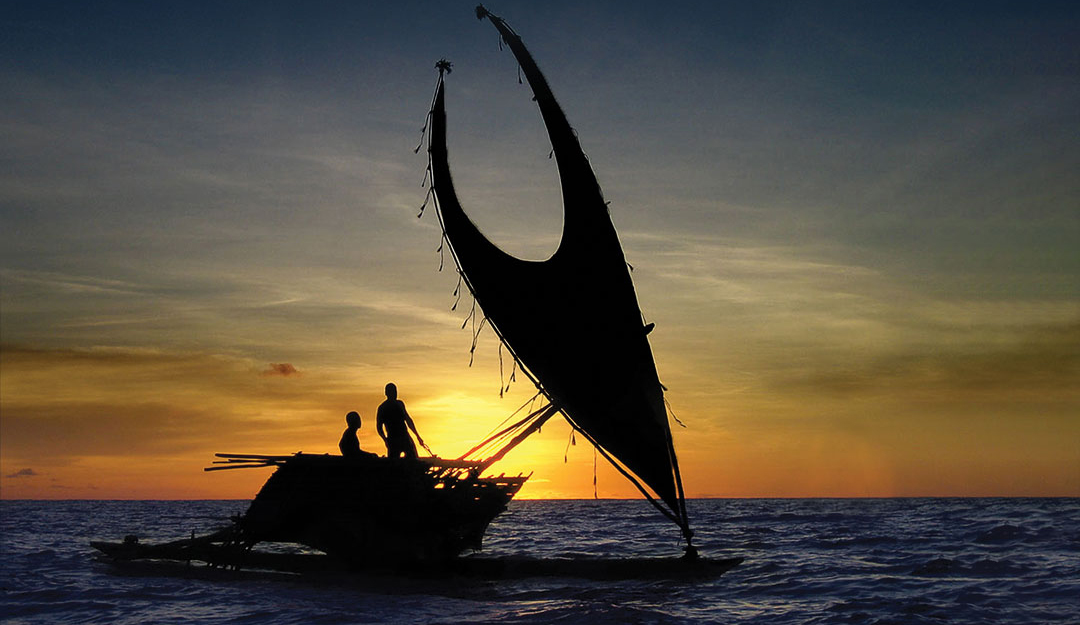Marianne “Mimi” George
Principal Investigator, The Vaka Taumako Project
Around four thousand years ago, Austronesian-speaking people sailed from Taiwan into the greater Pacific. A thousand years later, they were the first people to land in Vanuatu and Tonga. Then these Austronesian voyagers mixed with Papuan populations in what is now Papua New Guinea, and those people later became the Polynesian voyagers. Evidence now suggests that the extent of Austronesian and Polynesian voyaging was greater than once thought, ranging from Madagascar to Brazil—over two-thirds around the globe. The seafaring vessels that the Austronesian voyagers created were the vehicles of the greatest human migration ever made.
However, when the Europeans colonized the Pacific, the ancient voyaging networks and traditional shipbuilding practices collapsed. But no practical or affordable technology has ever replaced them. Then after over forty years of near isolation, the Polynesian people of Taumako in the southeast Solomon Islands made themselves a new voyaging canoe. Young Taumakans began to make the designs and use the methods, tools, and materials of their ancestors. During the last twenty years, they completed three tepuke and three te alo lili.
The building processes the Taumakans employ today are based on the ones that their ancestors used in building tepuke. Each step in the building process is based on extensive knowledge of marine environments, materials, tools, and culture. One learns to build this vessel experimentally as key measurements and methods are not written down. They are shown and executed in practice and cannot be learned by studying words.
Community, Resources, and Culture
The tepuke building process is a community endeavor that incorporates many traditional food rituals. As such, before building even begins, the community plants seven to ten large gardens to grow food, which will be eaten as part of the daily feasting rituals. It is only after the gardens are ready that the builders begin their work.
First they collect coconut husks and soak them in tidal sand before pounding and gathering fibers. When fibers are ready, they are twisted and braided into different cordage that will later be used for lashing. The bark of hau trees (Hibiscus tiliaceus) are cut into strands and twisted into lines for rigging and hauling.
Before felling a tree for the hull, the builders wait for the Te Ube bird to choose the right tree. Once the tree is selected, it is felled and barked, and the workers roughly shape the main hull. When it is ready, a hundred people join together and chant while hauling the hull to the shore. When they arrive, they have a feast.
To protect their work and themselves from sun and rain, the Taumakans build a roof over the partially constructed tepuke. And with the hull in place near the sea, it is dug out to a thickness between fifteen and twenty centimeters and the two ends (moamoa) are shaped.
The women of the community harvest and prepare Pandanas leaves and weave them to make eight sail panels (laula). The children gather and clean seaweed and then pound it into an adhesive paste (limu).
Constructing the crossbeams, end risers (taupou), side risers (papalova and papa matai), and outrigger platforms (katea and haehale) requires harvesting many different resources. For example, the front and rear pieces of riser box come from the Viake Talinge tree, but the side risers come from Nga tree buttresses while the crossbeams to float-ends strut (lou) are curved from the Kupenga tree, and the outrigger platforms are lashed from betel nut strips.
With the crossbeams, end and side risers, and outrigger platforms in place, the builders install the primary connectives (hakatu), secondary connectives (kaukaui), and primary floats (utongi and ama). Attaching the primary connectives involves driving two pairs of sticks into the crossbeams and primary floats while the primary floats are connected to the outrigger platform frames. The secondary connectives connect the floats to the outrigger platform frames. The horizontal stringer (opoalu) connects the crossbeam to the float-ends strut.
The next few steps involve a lashing with the builders first lashing the riser box parts together by cutting holes in the vertical ends of the taupou, matai, and papalova. After that, they use the hakatu connectives to lash the ama floats to the crossbeam.
The women use sago leaves to make the leaf panels for the roof and walls of the tepuke housing unit (haehale). To erect the haehale, the builders lash the wedge-shaped Betle wood frame to the katea.
After the haehale is in place, the builders make and attach nine windlasses. Four hold the crossbeams to the hull, three hold the riser box, and two span the crossbeam outboard and under the platforms. While the windlasses are being installed, the children pound coconut husks to make caulking, which is then later used with breadfruit sap putty for waterproofing. The final step in preparing the tepuke body is for the builders to carve a figure of the Te Ube bird in the moamoa.
The finishing touches involve sewing the sail panels together to create the full sail (te la), cutting the sail mast, and running the rigging lines as well as installing the steering blades with a smaller one for the floats and a bigger one for the hull. The final product is then put through vigorous testing before being delivered.







